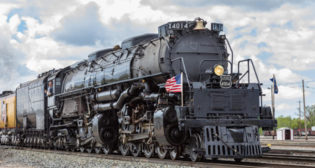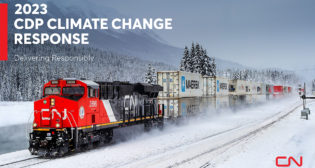
Engines of change
Written by William C. Vantuono, Editor-in-Chief
State-of-the-art locomotives stand ready to make their mark on what is ideally a power-hungry industry. Problem is, with traffic down, the railroads aren’t so hungry for new power.
Tier 4 locomotives are a little bit like DOT-117 hazmat tank cars. The industry has invested valuable resources and time attempting to attain a lofty and largely unfunded regulatory goal (in this case, the EPA’s). But now that the regs are in place, the size of the existing fleet is too big for the number of train starts, so a lot of this state-of-the-art equipment will have to wait before the market demands that new power be pressed into service. Many locomotives are now stored serviceable, a term that equipment lessors and OEMs would rather not hear.
“Two years ago, every serviceable locomotive was reactivated,” noted Oliver Wyman’s Jason Kuehn at Rail Equipment Finance 2016. “Now, 15% or more of the road locomotive fleet is in storage. The price spread between natural gas and diesel has choked off interest in LNG and CNG-fueled locomotives. And Tier 4 emissions levels are so strict that they’ve halted the virtuous cycle supporting locomotive replacement. We’ve gone from the perfect storm to a dead calm in two short years.”
So what’s a locomotive builder to do, besides try to adapt to market conditions that seem to happen faster than the time it takes to rebuild a prime-mover?
If you’re an OEM and/or rebuilder, large or not-so-large—Progress Rail/EMD, GE Transportation, NRE, MotivePower, Railserve, RJ Corman, Brookville Equipment, Knoxville Locomotive Works, Republic Locomotive, etc.—you press ahead with R&D, look for new markets (China, India, Russia, South Africa), attempt to fill a niche market, or maybe even test the passenger locomotive market. At least that segment seems to be growing.
Engines of Change
There isn’t a locomotive builder that isn’t offering something new and/or innovative in 2016. Following is a partial rundown.
• EMD’s Tier 4 freight locomotive, the SD70ACe-T4, is powered by an all-new, 4,400-traction-hp, 12-cylinder, four-stroke EMD-developed 1010 diesel engine. EMD attained Tier 4 without the use of urea as an after-treatment. The 1010 is a radical departure from EMD’s traditional two-stroke engine. It is not based on a Caterpillar engine, though, according to Progress Rail President and CEO Billy Ainsworth, it “combines the engineering expertise of Progress Rail, Electro-Motive and Caterpillar.” EMD’s other Tier 4 offering, the F125 Spirit high-speed passenger locomotive, utilizes a 4,700-hp Caterpillar C175-20 engine.
The SD70ACe-T4 includes a high performance AC traction system, isolated powertrain, radial bogies, individual axle control, advanced electronics and an enlarged cab designed for crew ergonomics and safety. EMD plans to have these locomotives available in the second half of 2016.
• MotivePower’s MP54AC for GO Transit is the first regional/commuter locomotive in North America certified to meet Tier 4 emissions standards. The MP54AC is a repower of existing GO Transit MP40PH-3C locomotives utilizing twin Tier 4 Locomotive-certified Cummins QSK60 engines that produce up to 5,400 hp for traction power and HEP (head end power). The QSK60 meets Tier 4 using integrated SCR (Selective Catalytic Reduction) exhaust after-treatment technology, which removes NOx from the exhaust stream, enabling reduced emissions and improved fuel efficiency. The technology reduces diesel particulate emissions by about 85% and NOx (nitrous oxide) emissions by about 75%, compared to the locomotive’s original Tier 2 configuration. The twin-engine setup provides for redundancy of major systems and flexibility of operation during off-peak periods, where running just one of the engines can provide significant fuel savings on shorter trains.
• GE’s Evolution Series Tier 4 locomotive is powered by GE’s 12-cylinder EVO engine and requires no after-treatment system. Requiring ultra-low-sulfur ASTMD975 Diesel #2 fuel, its advanced air-to-air cooling system “enhances performance and lowers emissions.” It’s equipped with a VSPD control system that does not require an auxiliary alternator.
• NRE’s NREX 2015 Genset last year became the first locomotive to be verified by the California Environmental Protection Agency as achieving Tier 4 emission standards. CARB (California Air Resources Board) verified the locomotive at NOx and PM (particulate matter) emission levels at or below of 1.0 and 0.01 g/bhp-hr (grams per brake horsepower-hour), respectively, qualifying NRE locomotives for the Carl Moyer Emissions Grant Program, which provides locomotive-funding grants of up to 85% of the total locomotive cost, as a trade-in transaction. The California-based program requires that the locomotive manufacturer hold a Tier 4 CARB Verified Certificate.
Independent axle control (IAC) is a distinguishing feature of NRE’s NR33CDE-IAC road switcher, more commonly referred to as an SD40-IAC or an SD40-4. It’s built on an SD40-2 platform equipped with an EMD 645E3B prime-mover. When employed in hump yard service, the DC-traction NR33CDE-IAC offers a unit reduction of one locomotive over a three-unit consist of SD40-2s. This is mostly attributable to a 50% adhesion factor increase over an SD40-2, achieved with NRE’s DC chopper module and N-Force microprocessor control system. Performance, says NRE, “is equivalent to that of an AC-traction locomotive.” This locomotive can also be employed in line-haul service.
• The first Railserve DUAL LEAF® Gen-Set locomotive to meet Tier 4 environmental regulations will hit the rails early this summer, and Railserve expects to launch regular production almost immediately after.
The DUAL LEAF was developed specifically for shippers, industrial railroads, and short lines that operate where there is a need for high tractive effort at speeds up to 30 mph. “The units are cost-effective at high-utilization rates, and the Cummins QSX15 has been a reliable and proven engine for our LEAF locomotives,” says T.J. Mahoney, LEAF Program Manager. “Now that the unit is available as a Tier 4-compliant model, we can equip the DUAL LEAF with this power source.”
The DUAL LEAF is being manufactured at the Railserve facility in Longview, Tex. The Tier 4 QSX15 engine has a footprint identical to the previous model, meaning there is no need for redesign or significant changes in the layout of the DUAL LEAF, which incorporates two of the Cummins engines. Mahoney says the Tier 4 DUAL LEAF will have improved operating performance and reduced environmental impact. As compared with conventional units, it will cut particulate emissions by 99% and NOx emissions by 92%. Fuel consumption is expected to drop even further because the Tier 4 units operate at lower RPMs in low-notch and idle phases, typical settings for most switching operations.
The original single-engine Railserve LEAF locomotive complies with regulations through 2017, “but if customers need them sooner, we are ready to produce Tier 4 single-engine systems,” says Mahoney.



